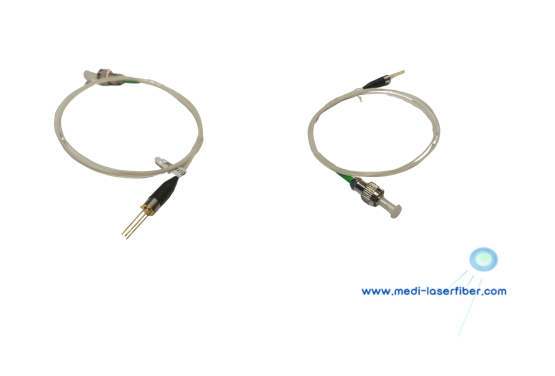1. Overview of Polarization-Maintaining Fiber Patch Cable
A polarization-maintaining fiber patch cable is a specialized type of fiber optic patch cable that can retain the polarization state of optical signals during transmission. While ordinary optical fibers are highly susceptible to polarization state changes caused by external factors, polarization-maintaining fibers are engineered to effectively prevent this issue. This characteristic makes them indispensable in applications demanding high polarization stability, such as fiber optic sensing, interferometry, and quantum communication.
2. Working Principle of Polarization-Maintaining Fiber
Polarization-maintaining fibers maintain the polarization of optical signals during transmission by introducing stress zones or unique structures within the fiber core. Common designs include:
- Panda Fiber: Symmetric stress zones are positioned on either side of the core, resembling a panda’s eyes.
- Bow-Tie Fiber: The stress zone is configured in a bow-tie shape, yielding a more pronounced birefringence effect.
- Elliptical Cladding Fiber: The polarization-maintaining function is realized through an elliptical cladding structure.
3. Structure of Polarization-Maintaining Fiber Patch Cord
A polarization-maintaining fiber optic patch cord consists of the following components:
- Optical Fiber: Made from quartz, the polarization-maintaining fiber serves as the core for signal transmission.
- Connector: Common types, such as FC, SC, and LC, ensure precise fiber – to – fiber connections.
- Sheath: Typically constructed from PVC or LSZH, the sheath safeguards the fiber from damage.
4. Precautions for Using Polarization-Maintaining Fiber Optic Patch Cords
- Alignment: To avoid polarization state alterations, connections must be accurately aligned with the fiber’s slow and fast axes.
- Cleanliness: Keeping the connector end faces clean is essential to prevent performance degradation due to contamination.
- Bending Radius: To avoid fiber damage, it is crucial to maintain a sufficiently large bending radius.
5. Common Problems and Solutions
- Excessive Insertion Loss: Check the cleanliness of the connector and the accuracy of the alignment.
- Low Polarization Extinction Ratio: Verify the alignment of the fiber’s slow and fast axes to ensure proper stress zone alignment.
- Low Return Loss: Inspect the connector end face for damage and replace it if necessary.
Polarization-maintaining fiber optics and ordinary fiber optics differ significantly in several aspects, as outlined below:
I. Structural Design
- Polarization-Maintaining Fiber:
- The core layer features a specialized design that equalizes the phase propagation speed of multiple modes, thereby maintaining the optical signal’s polarization state.
- The cladding may possess absorption capabilities, effectively eliminating unwanted polarization components of the optical signal and enhancing polarization maintenance.
- In certain polarization-maintaining fibers (e.g., SMA905 fiber), a specific angular relationship exists between the core and cladding, stabilizing the light polarization direction.
- Special materials, such as birefringent materials or appropriately shaped glass, are often incorporated to achieve polarization maintenance.
- Ordinary Fiber:
- The core layer is uniform and does not affect the polarization state of the optical signal.
- The cladding is also uniform, primarily serving to protect the core and provide mechanical strength and abrasion resistance.
- Lacking any special design or materials for polarization preservation.
II. Working Principle
- Polarization-Maintaining Fiber:
- Leveraging asymmetry and birefringence, it maintains a consistent polarization state of the optical signal.
- The two polarization components follow distinct paths during propagation, yet their relative phase difference remains constant.
- Ordinary Fiber:
- Due to its symmetric internal structure, the optical signal loses its polarization state during transmission.
- The direction of polarized light shifts as it travels through the fiber.
III. Application Scenarios
- Polarization-Maintaining Fiber:
- Predominantly utilized in applications requiring strict polarization maintenance, including optical communications, laser systems, fiber optic gyroscopes, medical imaging, and interferometric fiber optic sensors.
- Ordinary Fiber:
- Widely applied in general data transmission, sensor systems, and fiber optic amplifiers, such as home broadband and cable TV networks.
IV. Bandwidth
The asymmetric structure of the core and surrounding areas in polarization-maintaining fibers results in a relatively narrower transmission bandwidth compared to ordinary fibers.
V. Environmental Interference Resistance
Polarization-maintaining fibers exhibit superior resistance to environmental factors like temperature fluctuations, pressure variations, and bending, whereas ordinary fibers are more vulnerable to these influences.
For example in the application of Medical imaging: In optical coherence tomography (OCT) systems, polarization – maintaining fiber optic patch cables are often used. They help to maintain the polarization state of the light source, which is important for obtaining high – resolution images of biological tissues. By precisely controlling the polarization of the light, the contrast and resolution of the OCT images can be improved, facilitating the early detection and diagnosis of diseases.
VI. Production Cost
The manufacturing process of polarization-maintaining fibers involves more complex techniques, contributing to their higher production costs.
